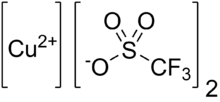Chemistry:Copper(II) triflate
From HandWiki

| |
| Names | |
|---|---|
| IUPAC name
Copper(II) trifluoromethanesulfonate
| |
| Other names
Copper(II) triflate
| |
| Identifiers | |
3D model (JSmol)
|
|
| ChemSpider | |
PubChem CID
|
|
| |
| |
| Properties | |
| C2CuF6O6S2 | |
| Molar mass | 361.67 g·mol−1 |
| Appearance | white to pale blue powder |
| very soluble, hygroscopic | |
| Hazards | |
| NIOSH (US health exposure limits): | |
PEL (Permissible)
|
TWA 1 mg/m3 (as Cu)[1] |
REL (Recommended)
|
TWA 1 mg/m3 (as Cu)[1] |
IDLH (Immediate danger)
|
TWA 100 mg/m3 (as Cu)[1] |
Except where otherwise noted, data are given for materials in their standard state (at 25 °C [77 °F], 100 kPa). | |
| Infobox references | |
Copper(II) triflate is the copper(II) salt of trifluoromethanesulfonic acid (known simply as triflic acid) which has a chemical formula of Cu(OSO2CF3)2, abbreviated Cu(OTf)2. This substance, first reported in 1972,[2] is a powerful Lewis acid. It is used as a catalyst in several organic reactions, such as the Diels–Alder reaction[3] and cyclopropanation reactions[4] (much like rhodium(II) acetate).
References
- ↑ 1.0 1.1 1.2 NIOSH Pocket Guide to Chemical Hazards. "#0150". National Institute for Occupational Safety and Health (NIOSH). https://www.cdc.gov/niosh/npg/npgd0150.html.
- ↑ Jenkins, C.L.; Kochi, J.K. (1972). "Solvolytic Routes via Alkylcopper Intermediates in the Electron-Transfer Oxidation of Alkyl Radicals". Journal of the American Chemical Society 94 (3): 843–855. doi:10.1021/ja00758a024.
- ↑ Evans, D.A.; Miller, S.J.; Lectka, T.; von Matt, P. (1999). "Chiral Bis(oxazoline)copper(II) Complexes as Lewis Acid Catalysts for the Enantioselective Diels–Alder Reaction". Journal of the American Chemical Society 121 (33): 7559–7573. doi:10.1021/ja991190k.
- ↑ Salomon, R.G.; Kochi, J.K (1973). "Copper(I) catalysis in cyclopropanations with diazo compounds. Role of olefin coordination". Journal of the American Chemical Society 95 (10): 3300–3310. doi:10.1021/ja00791a038.
 |

